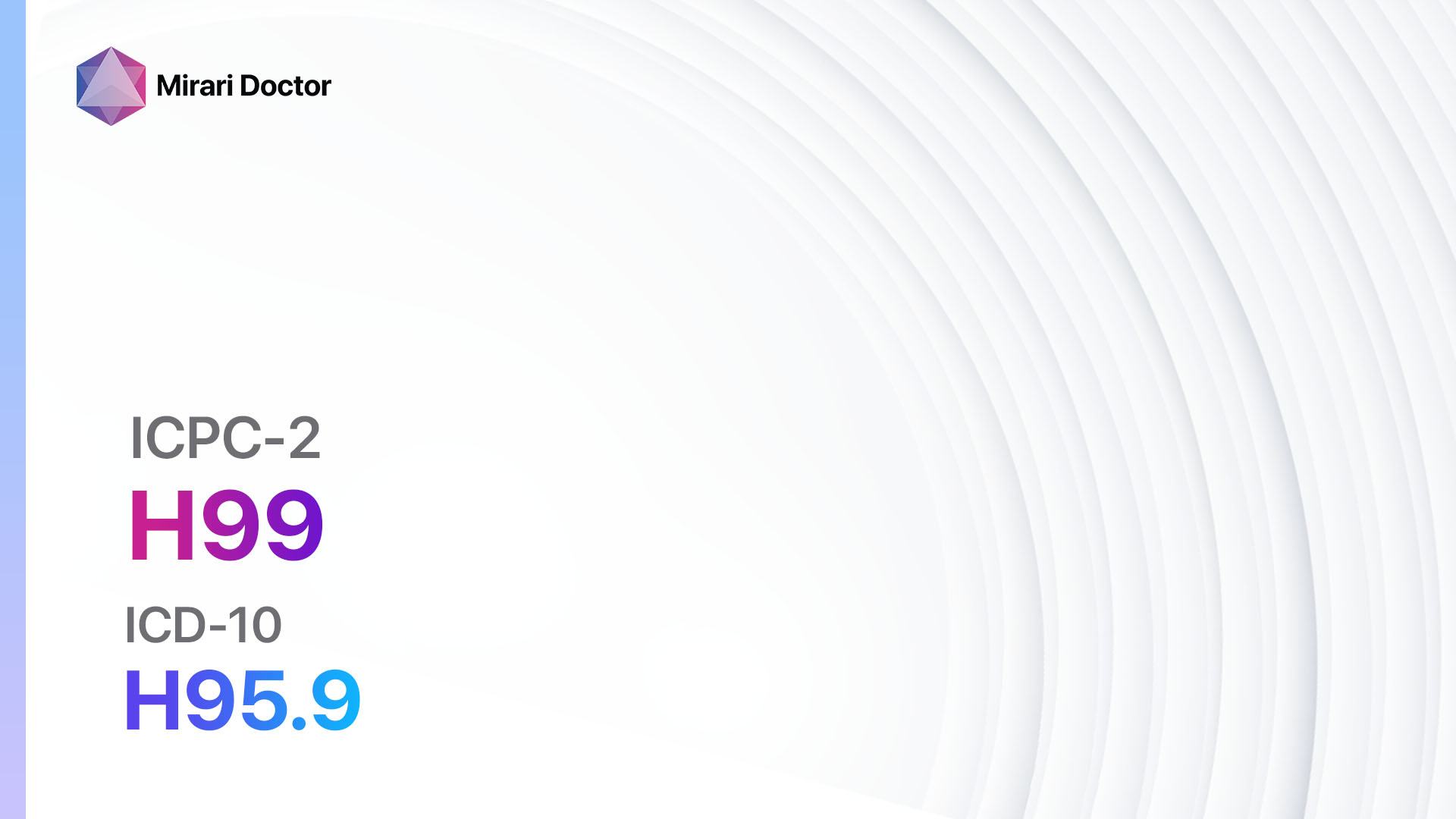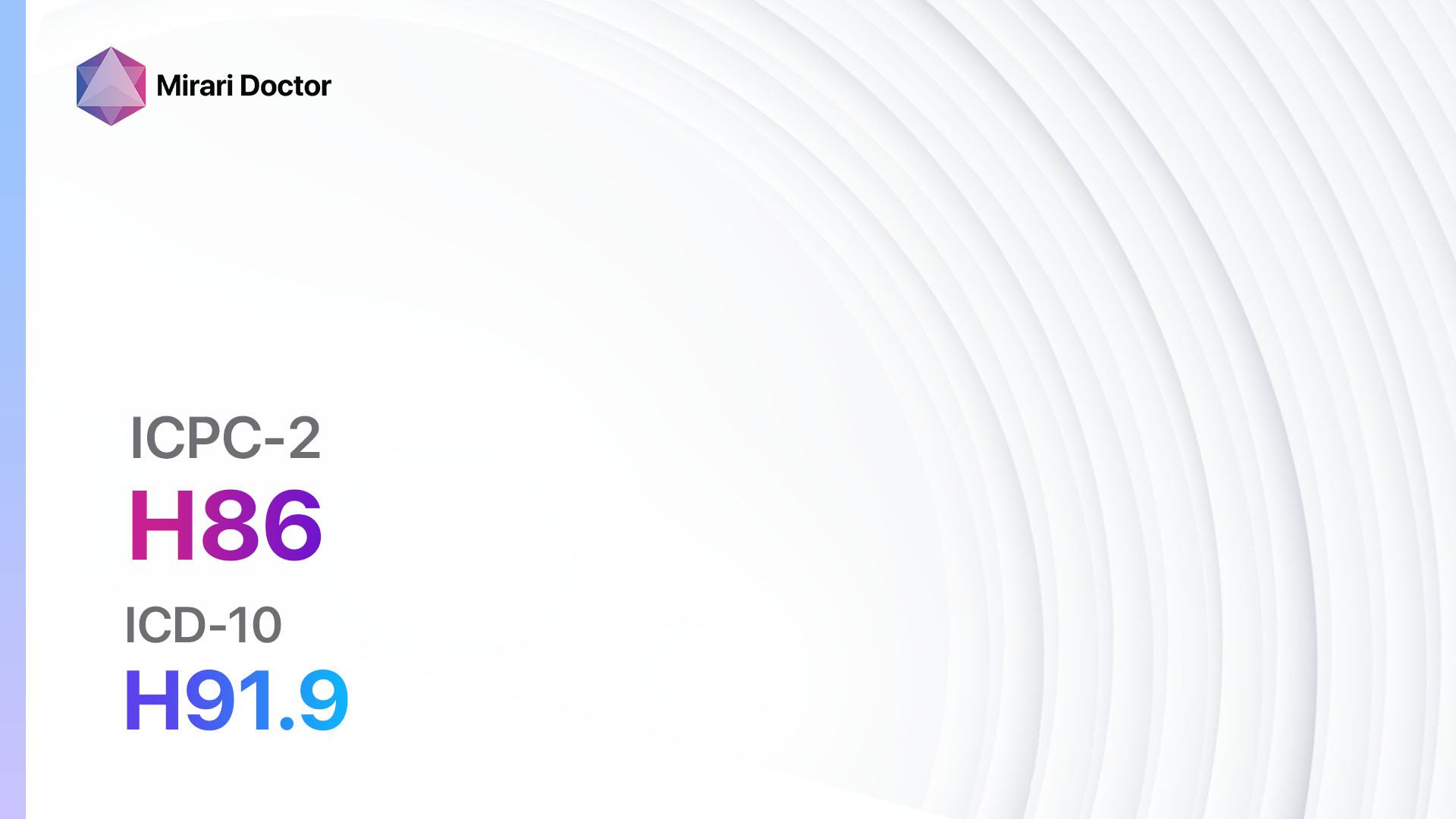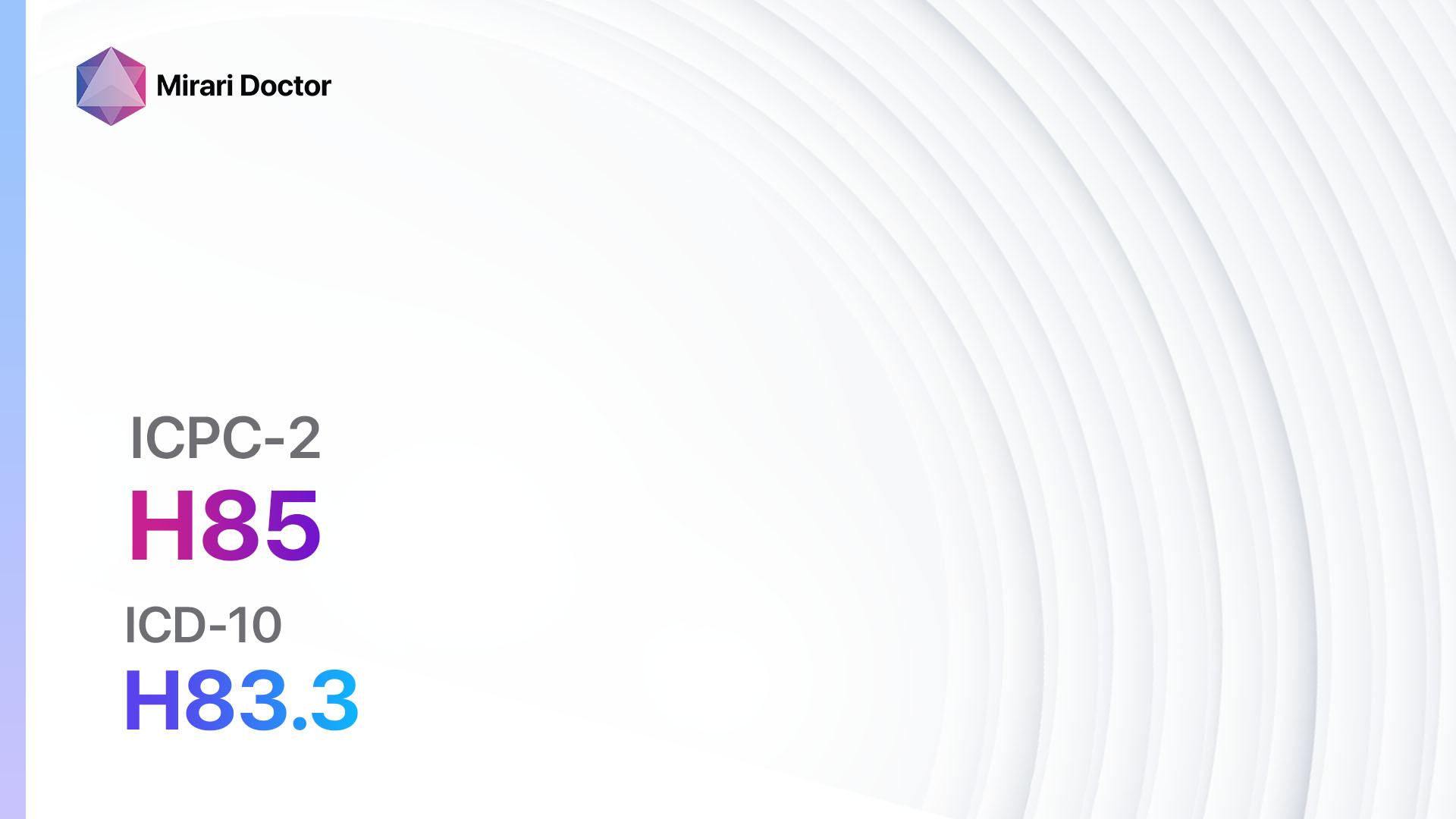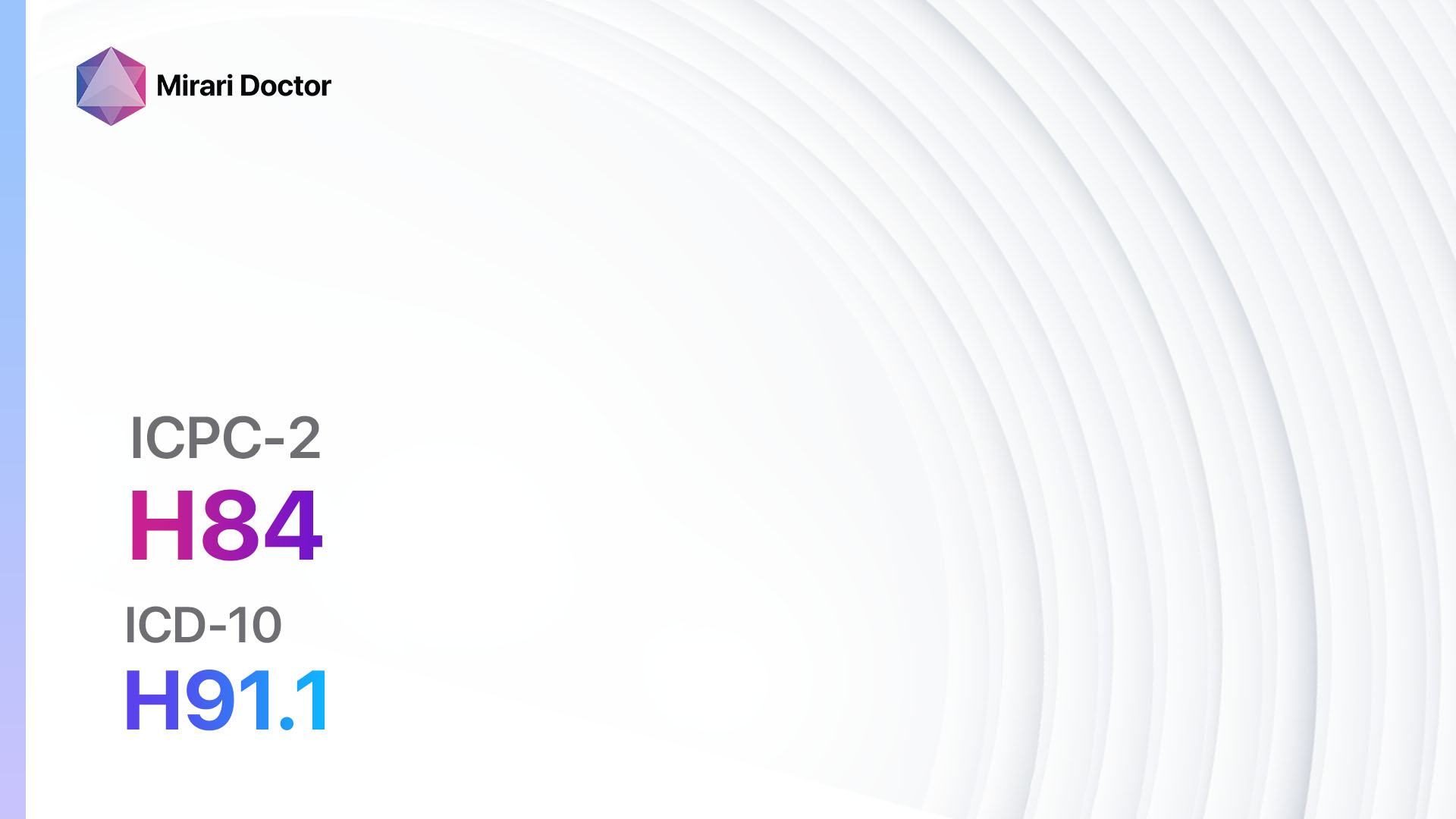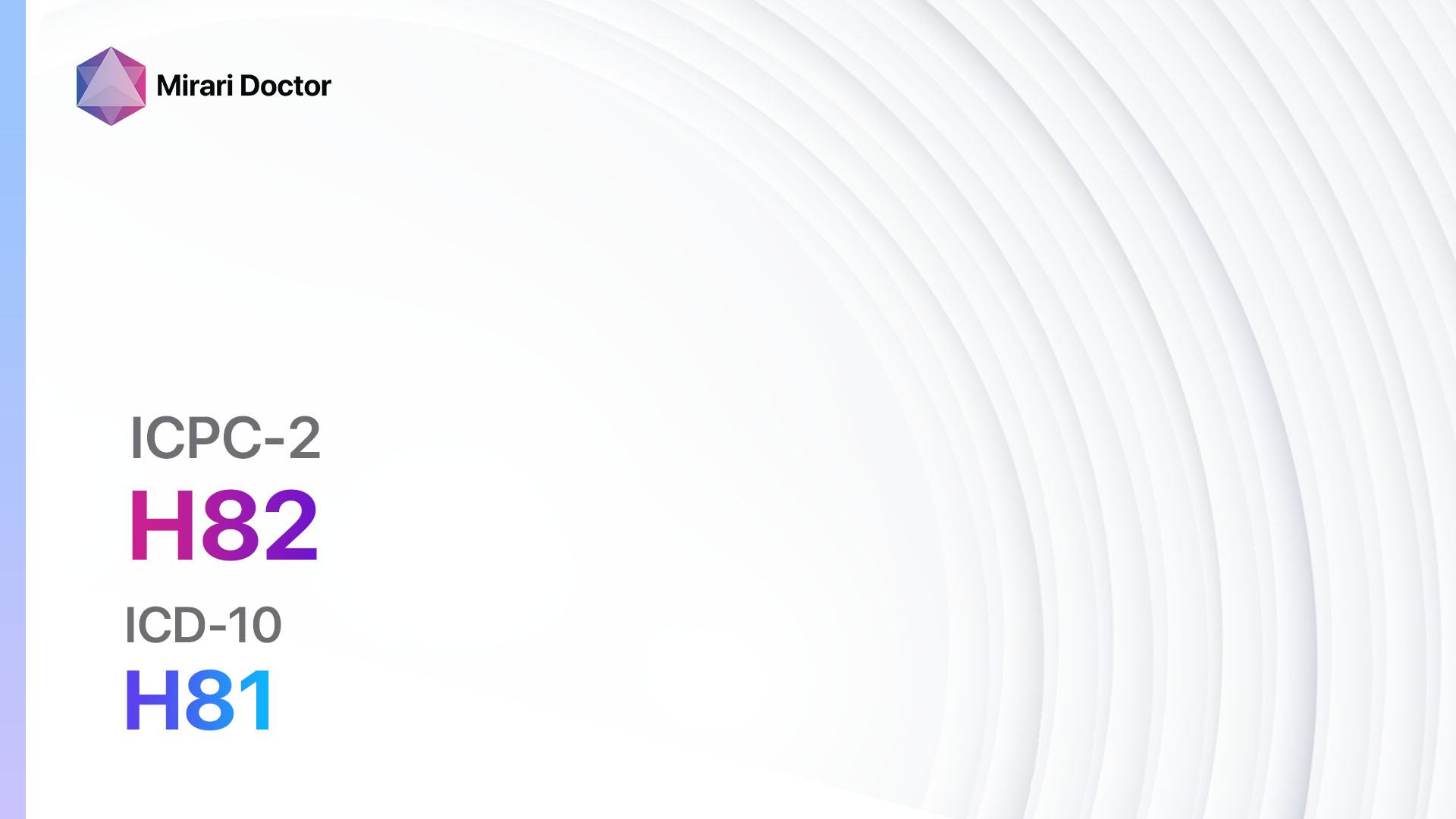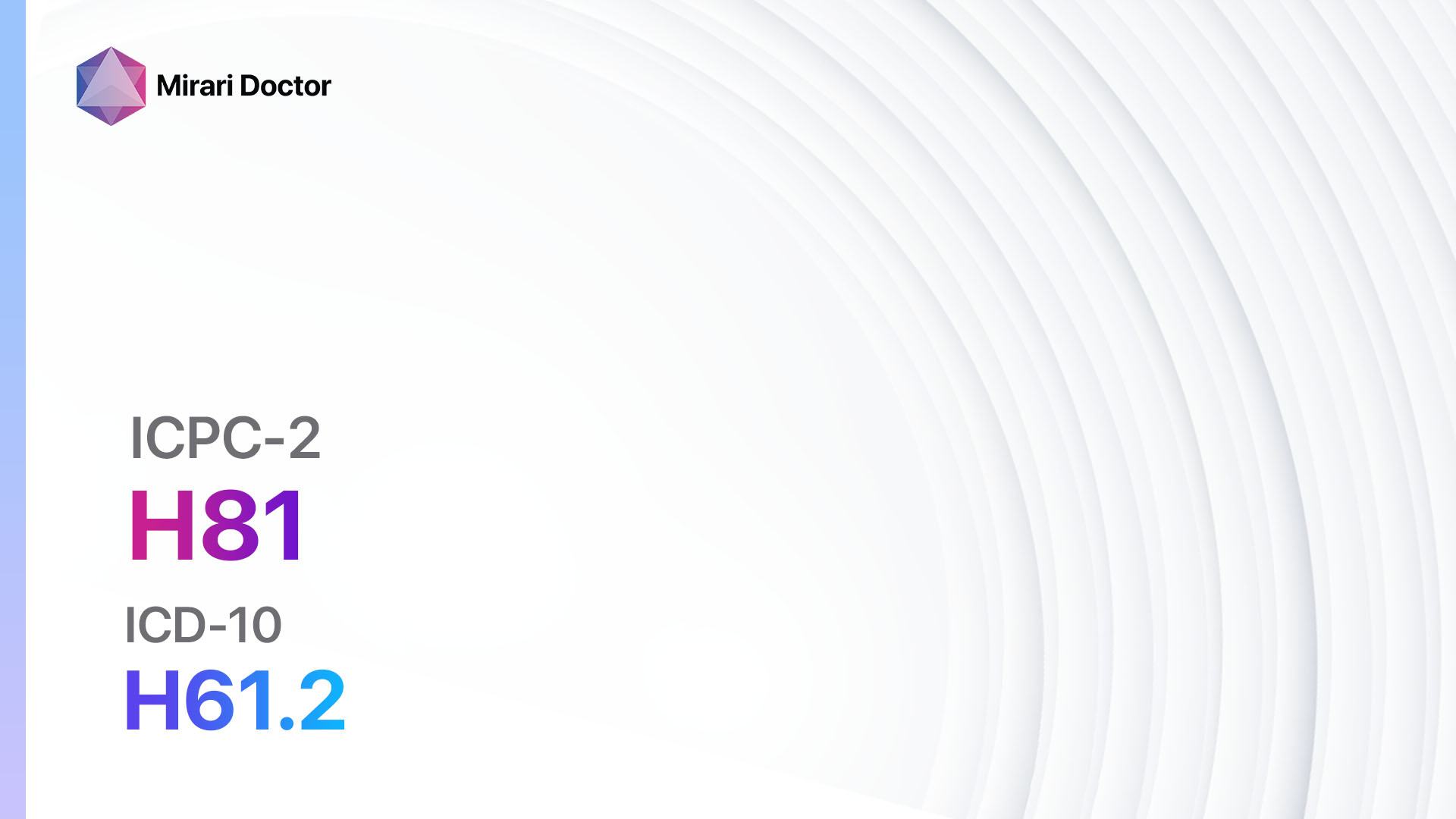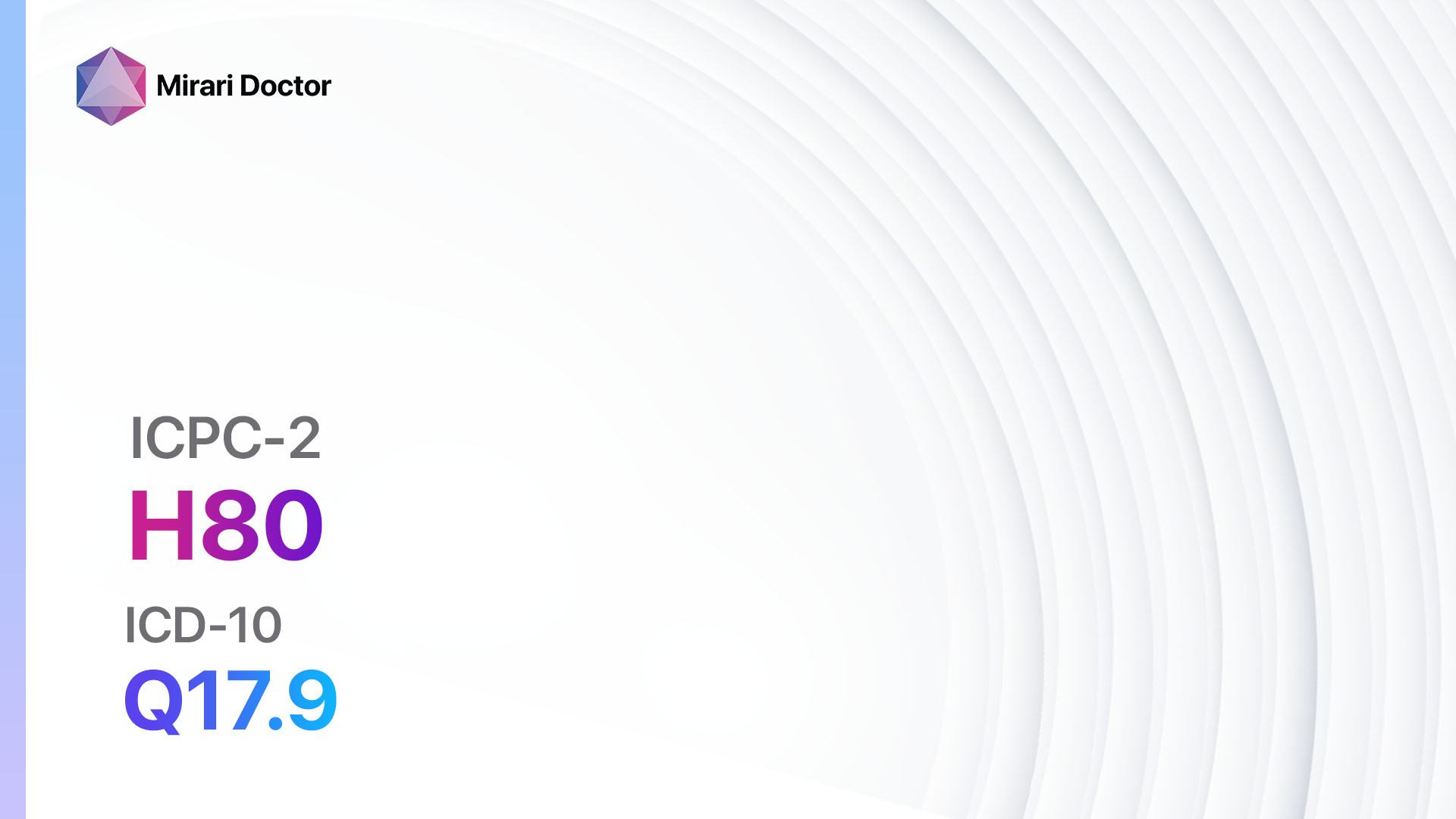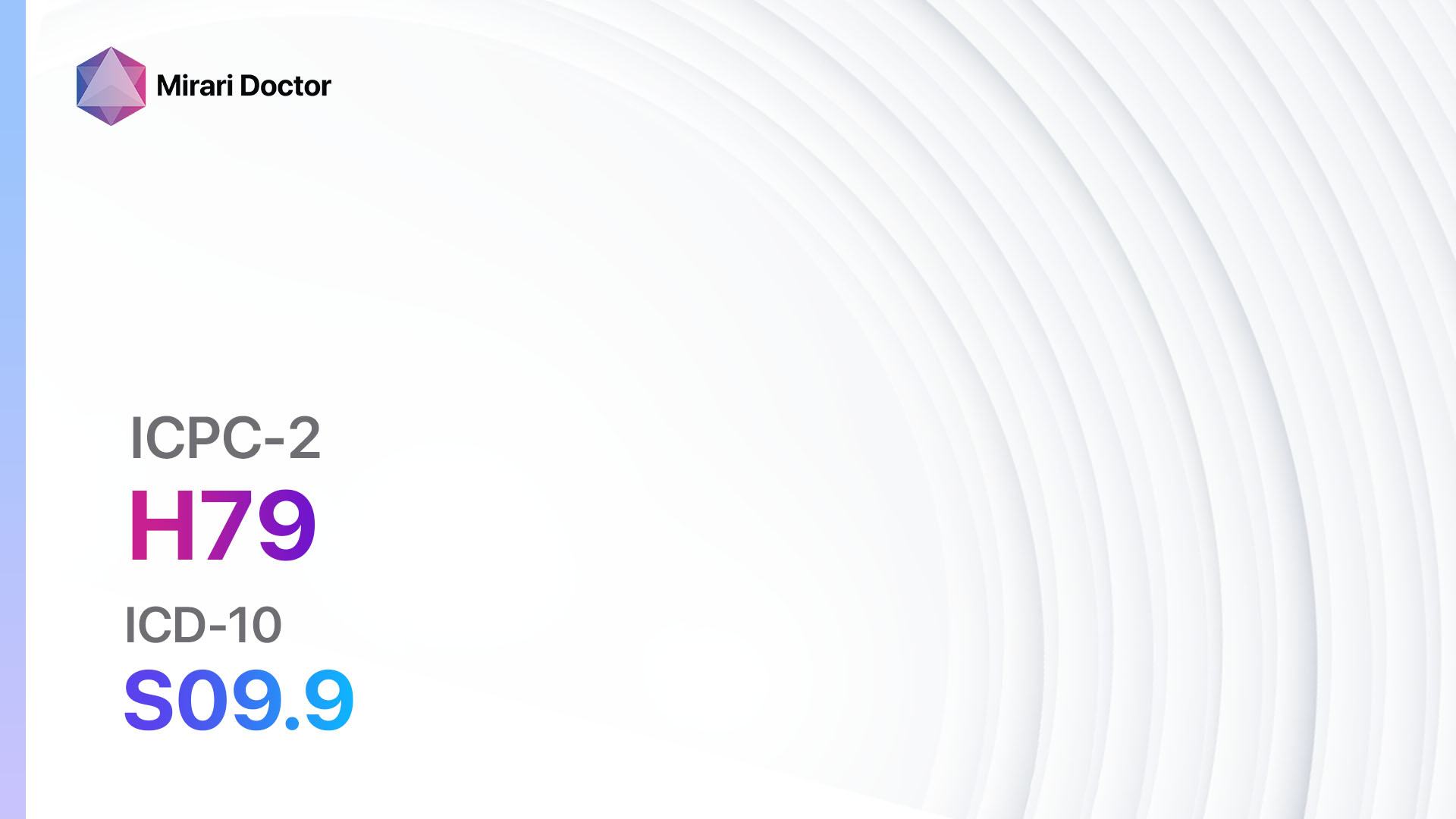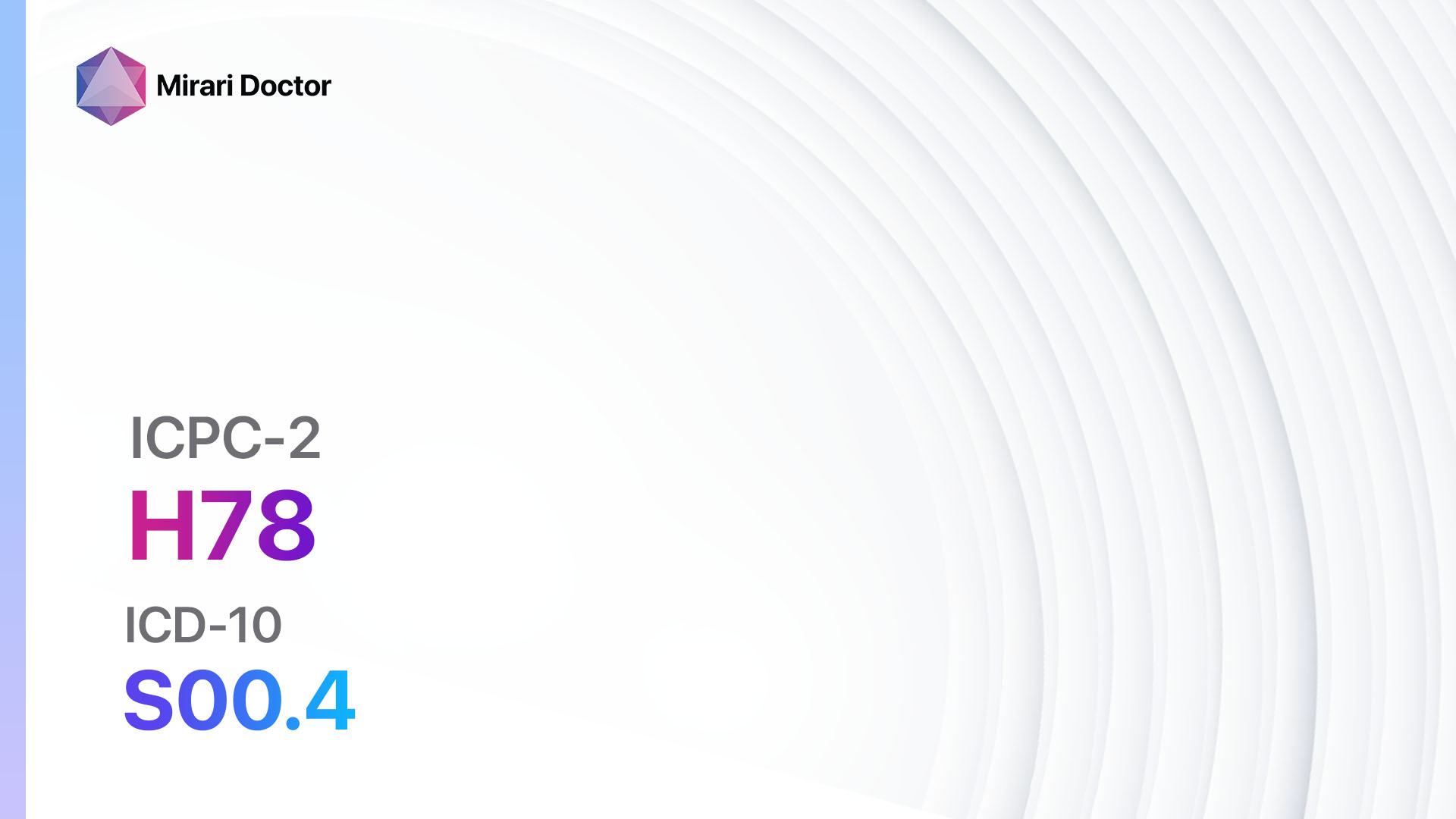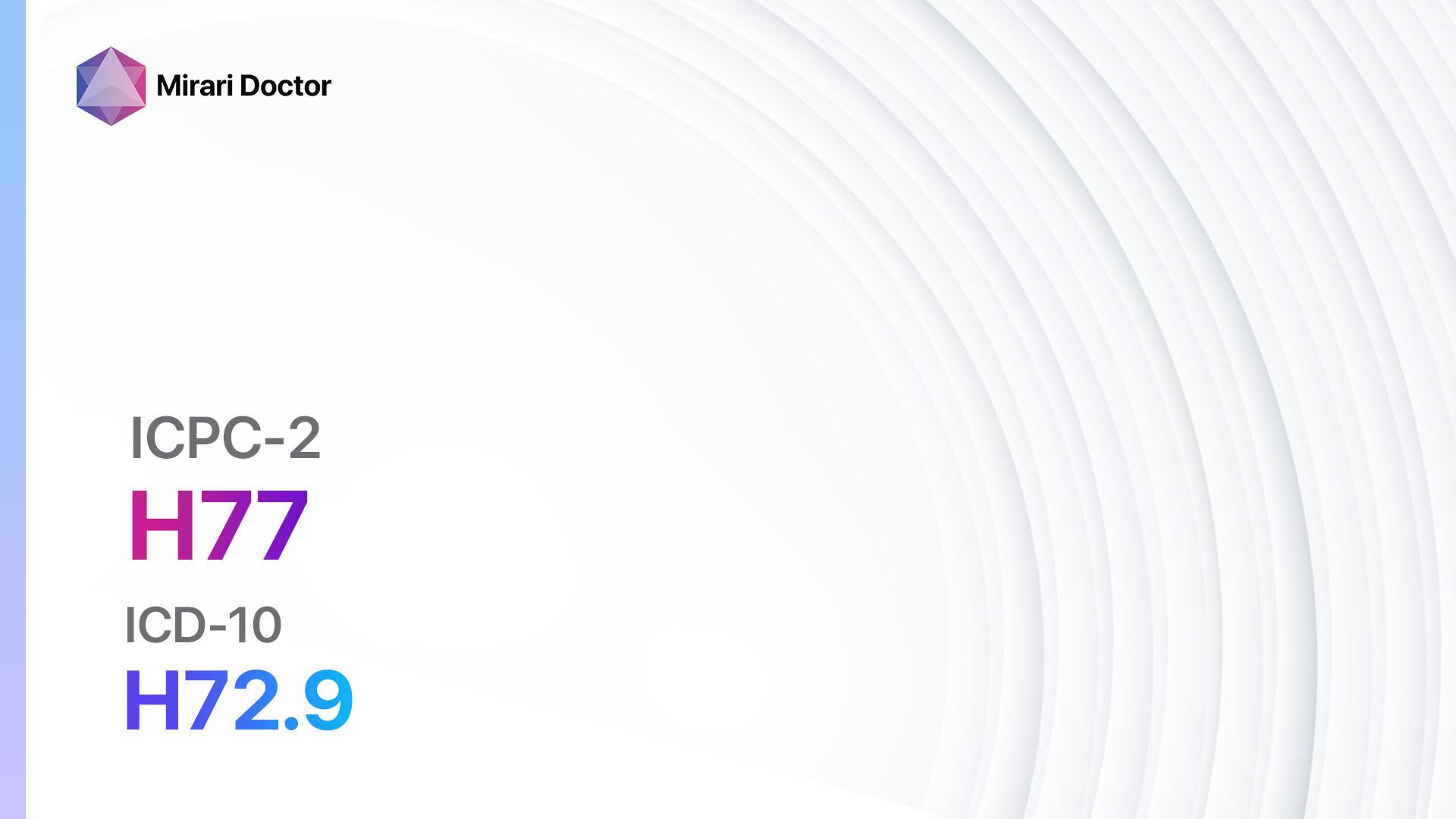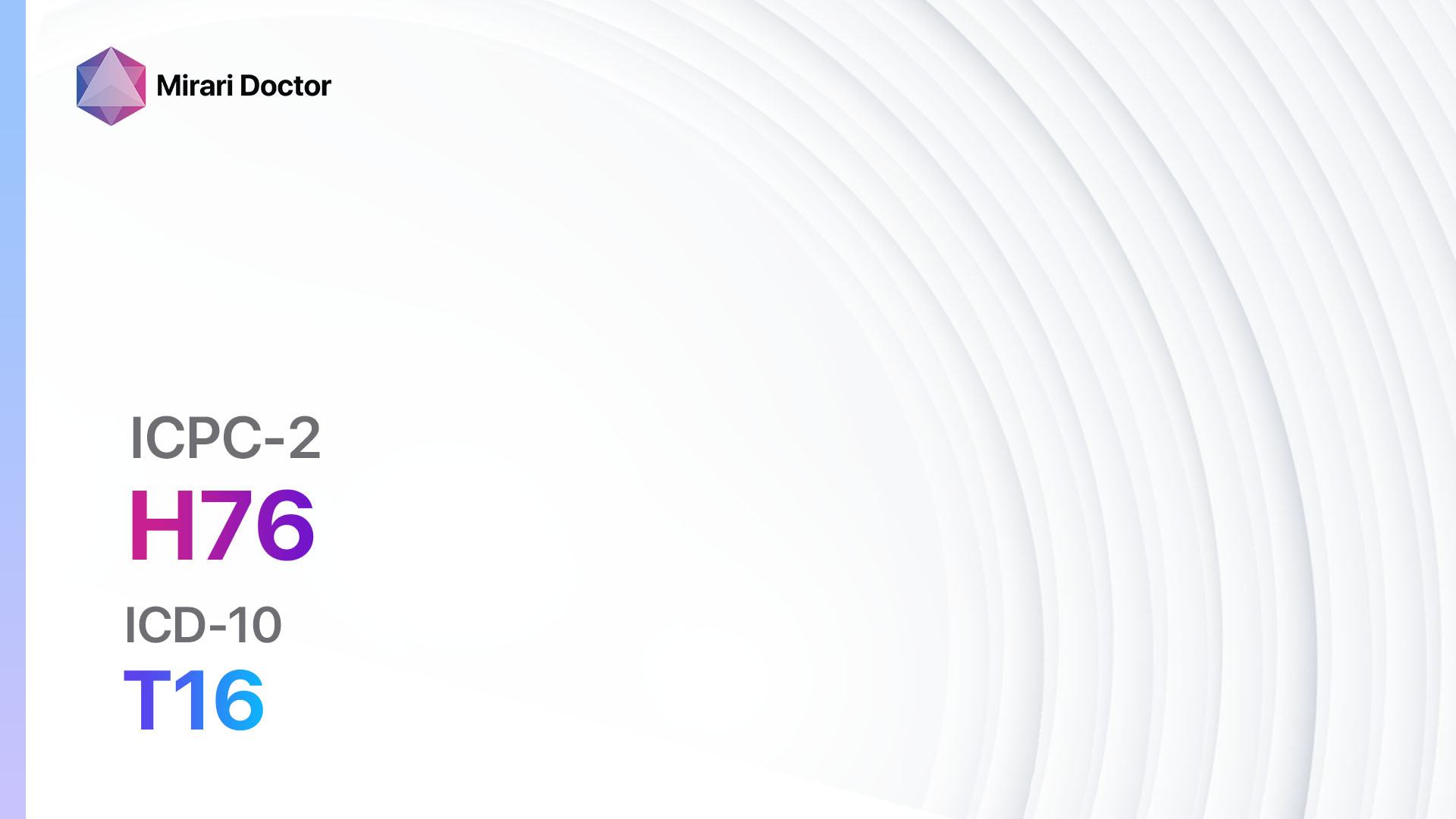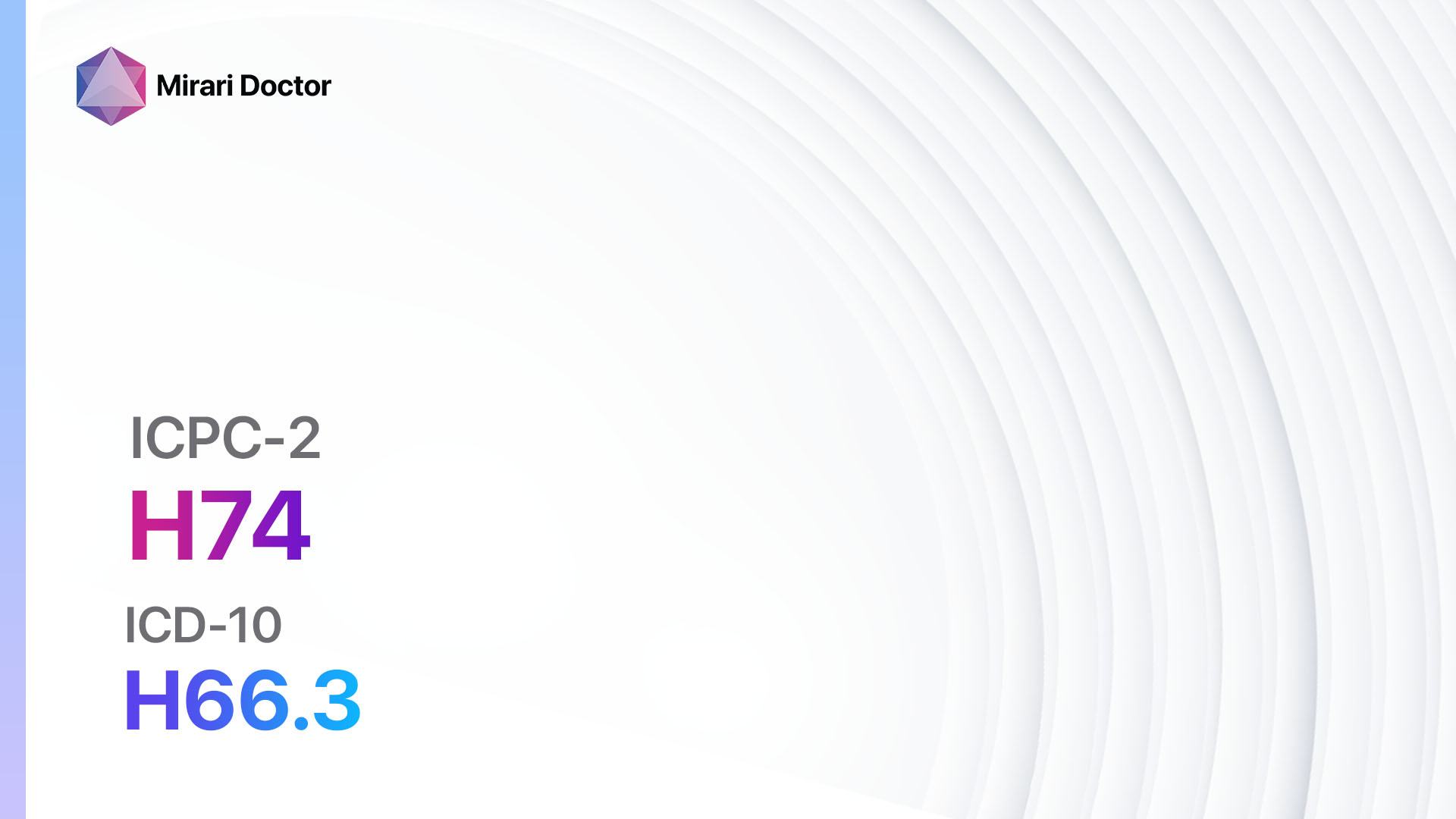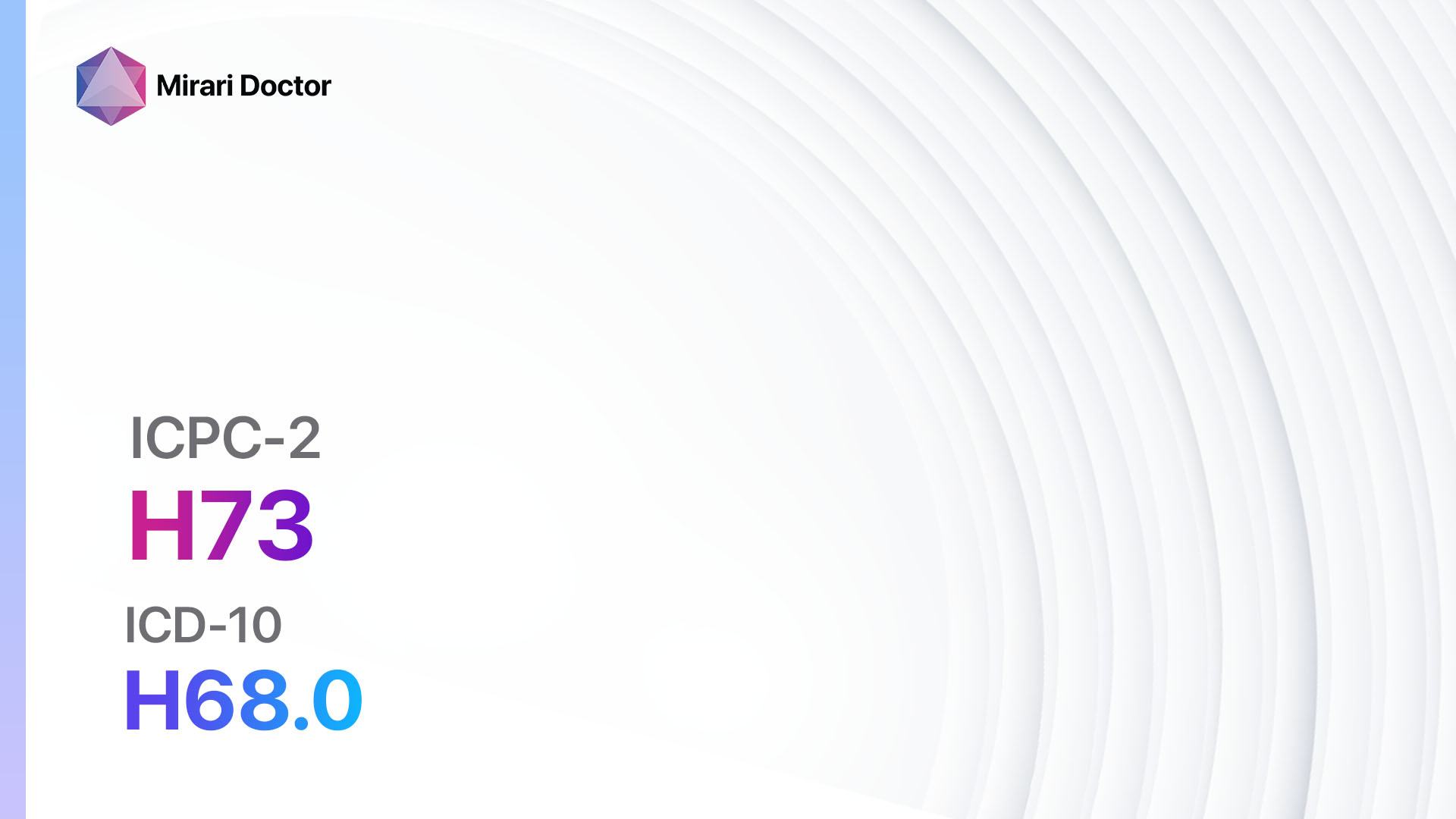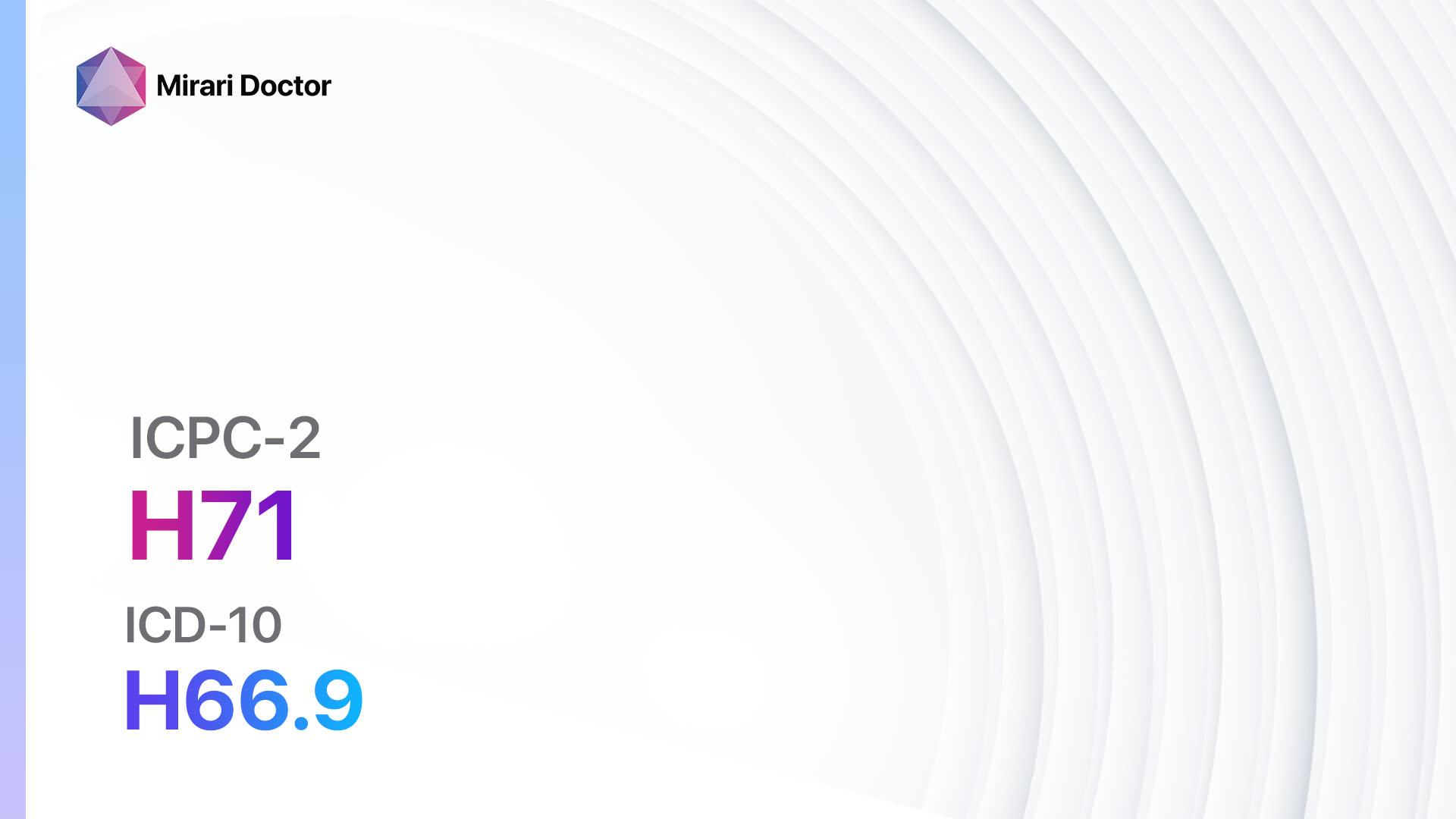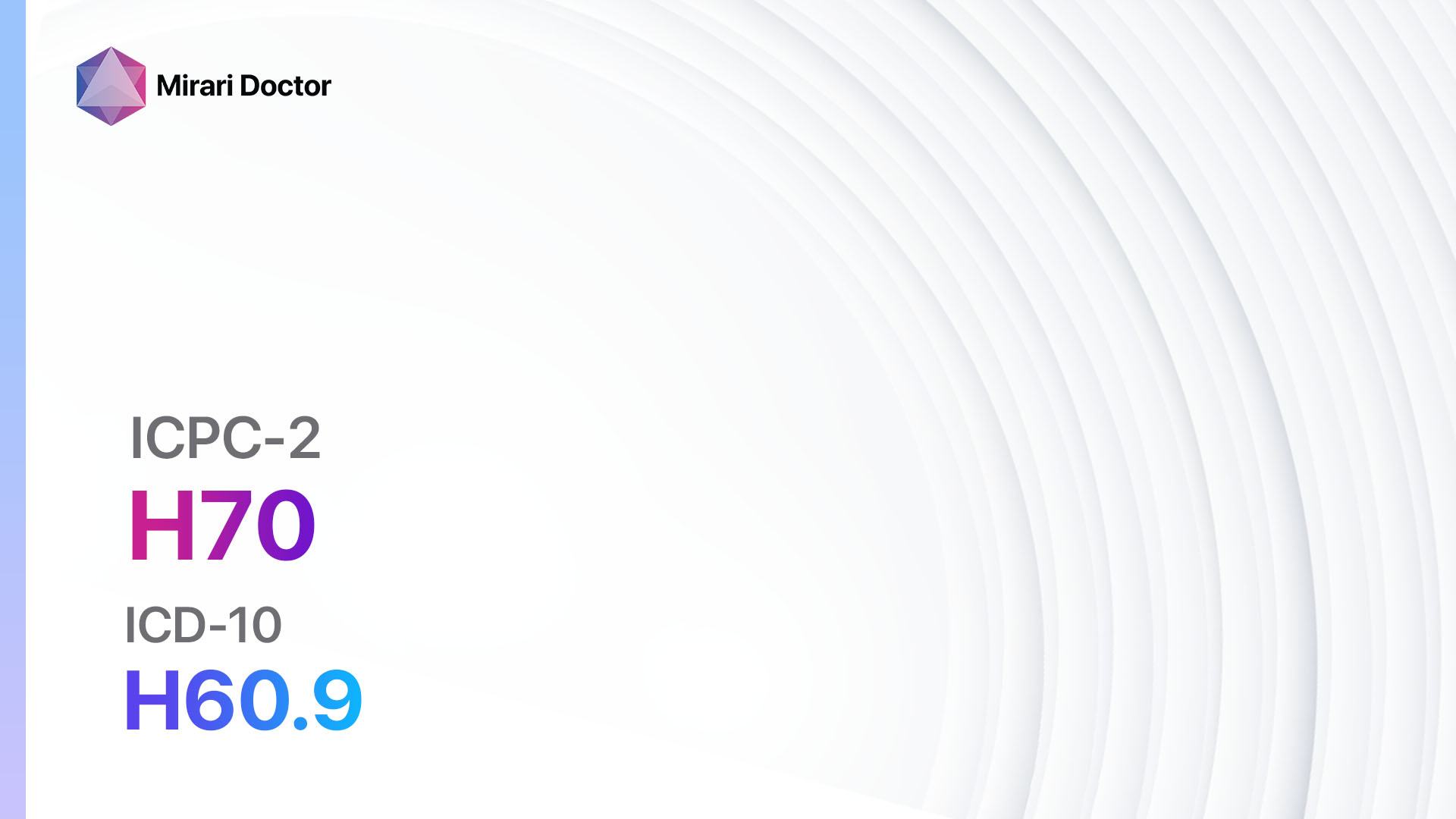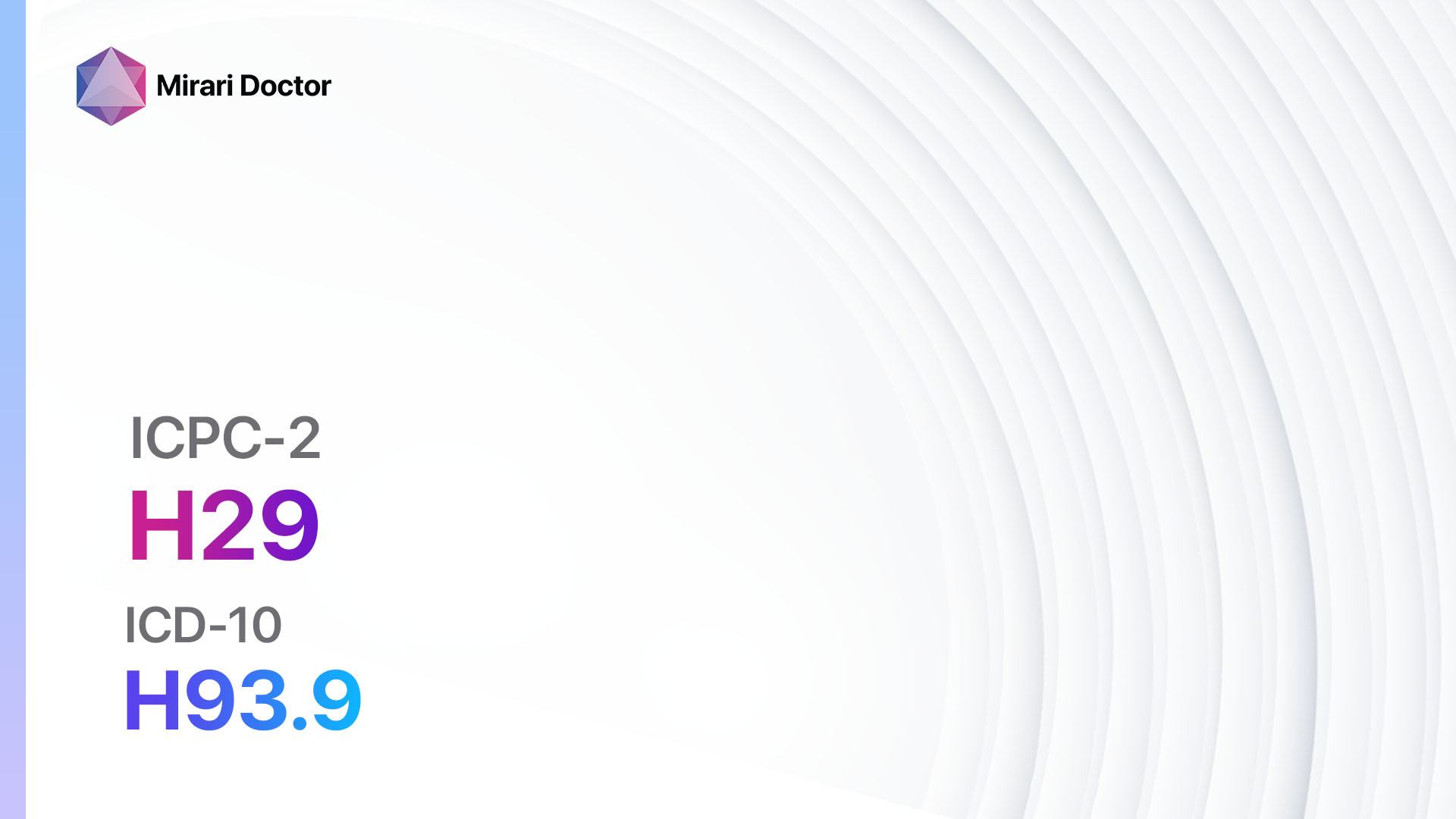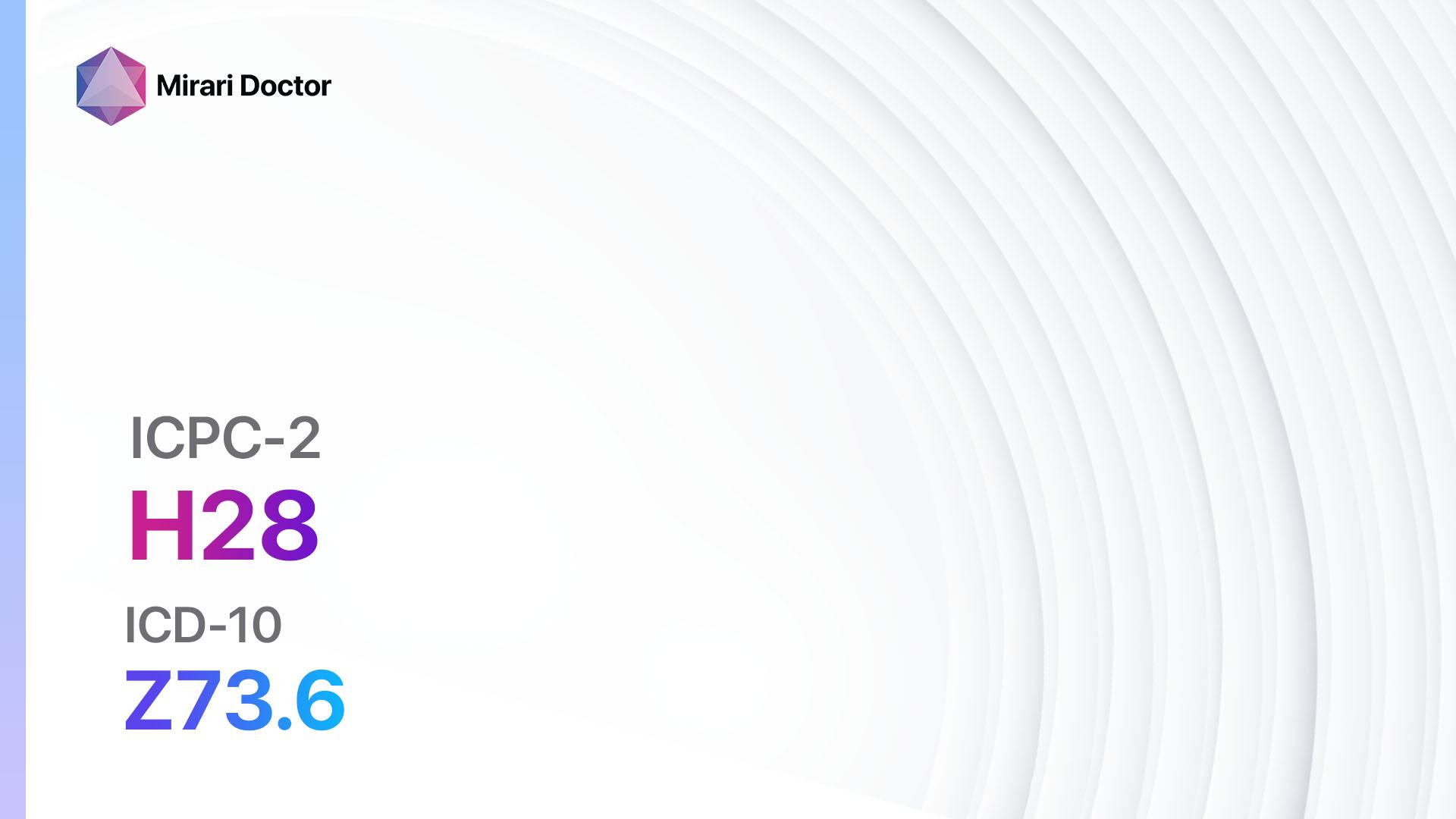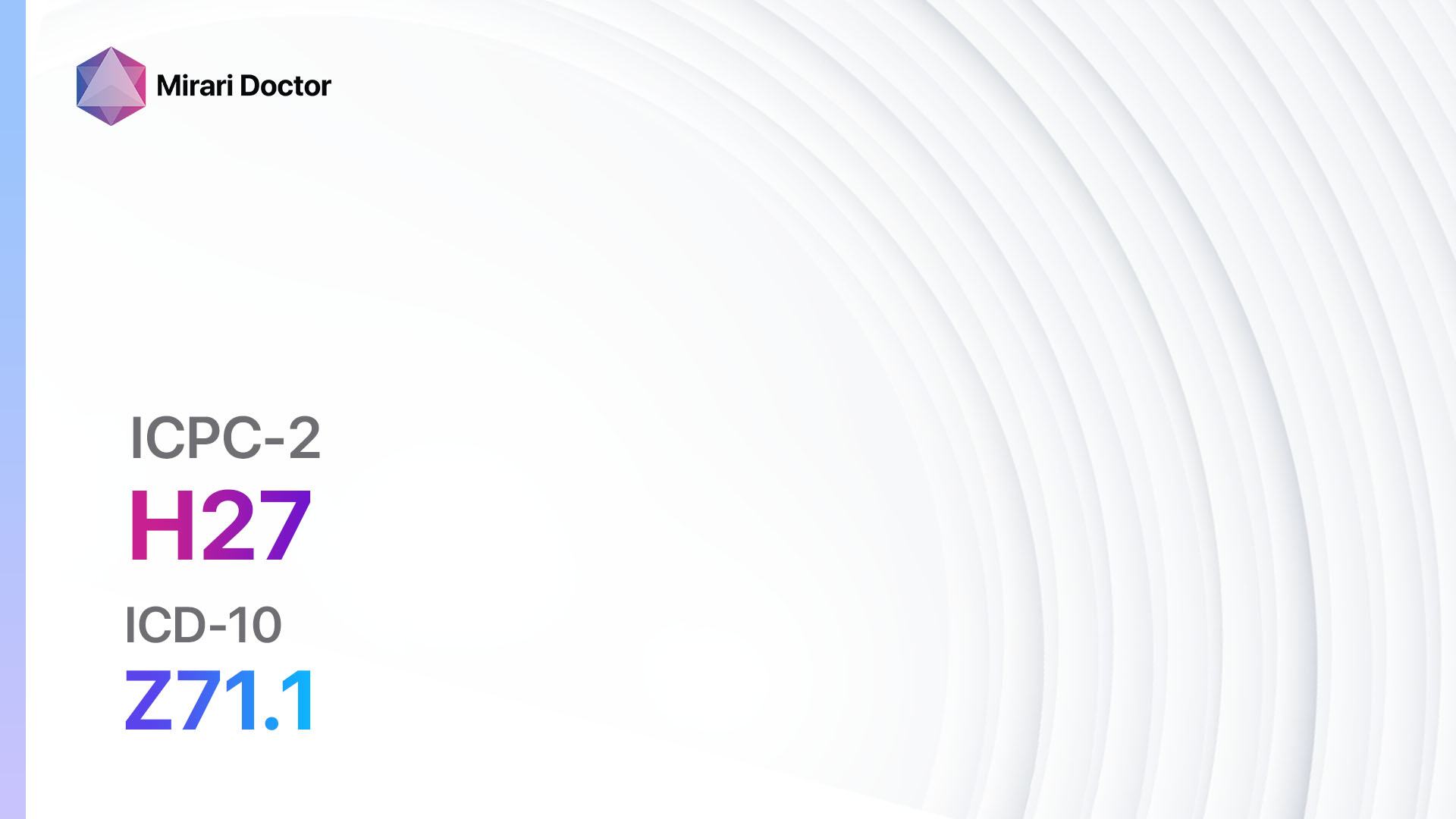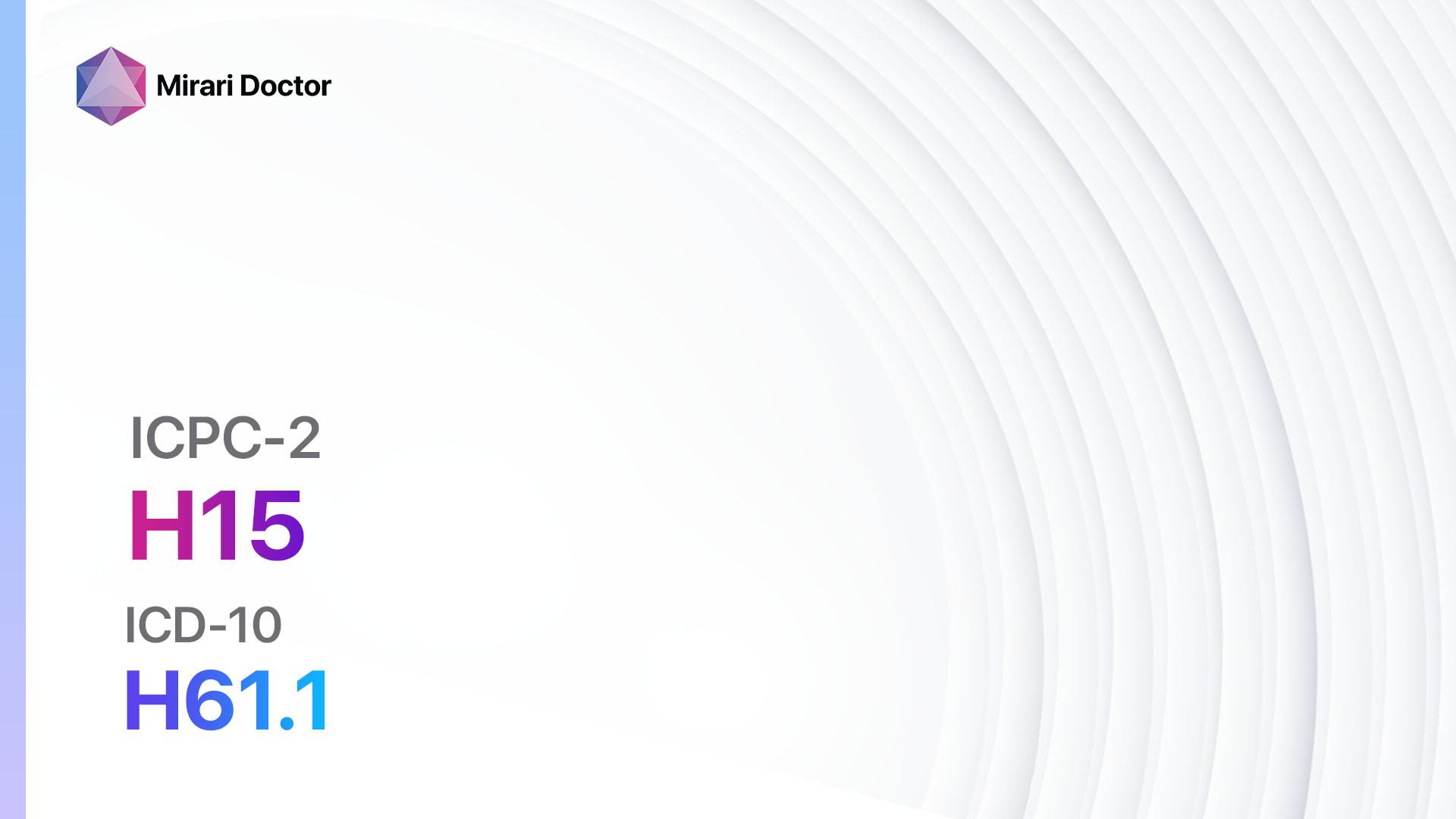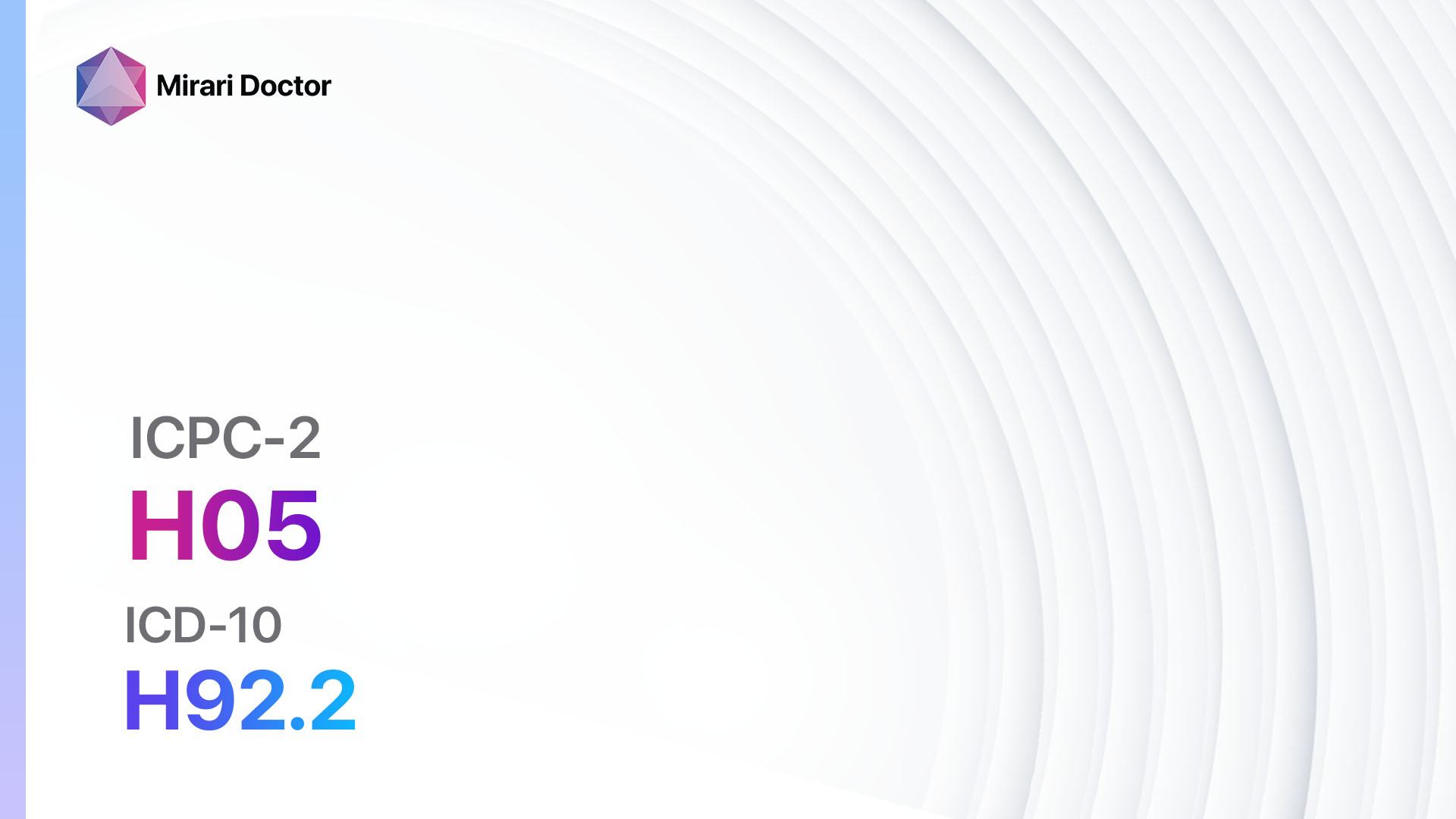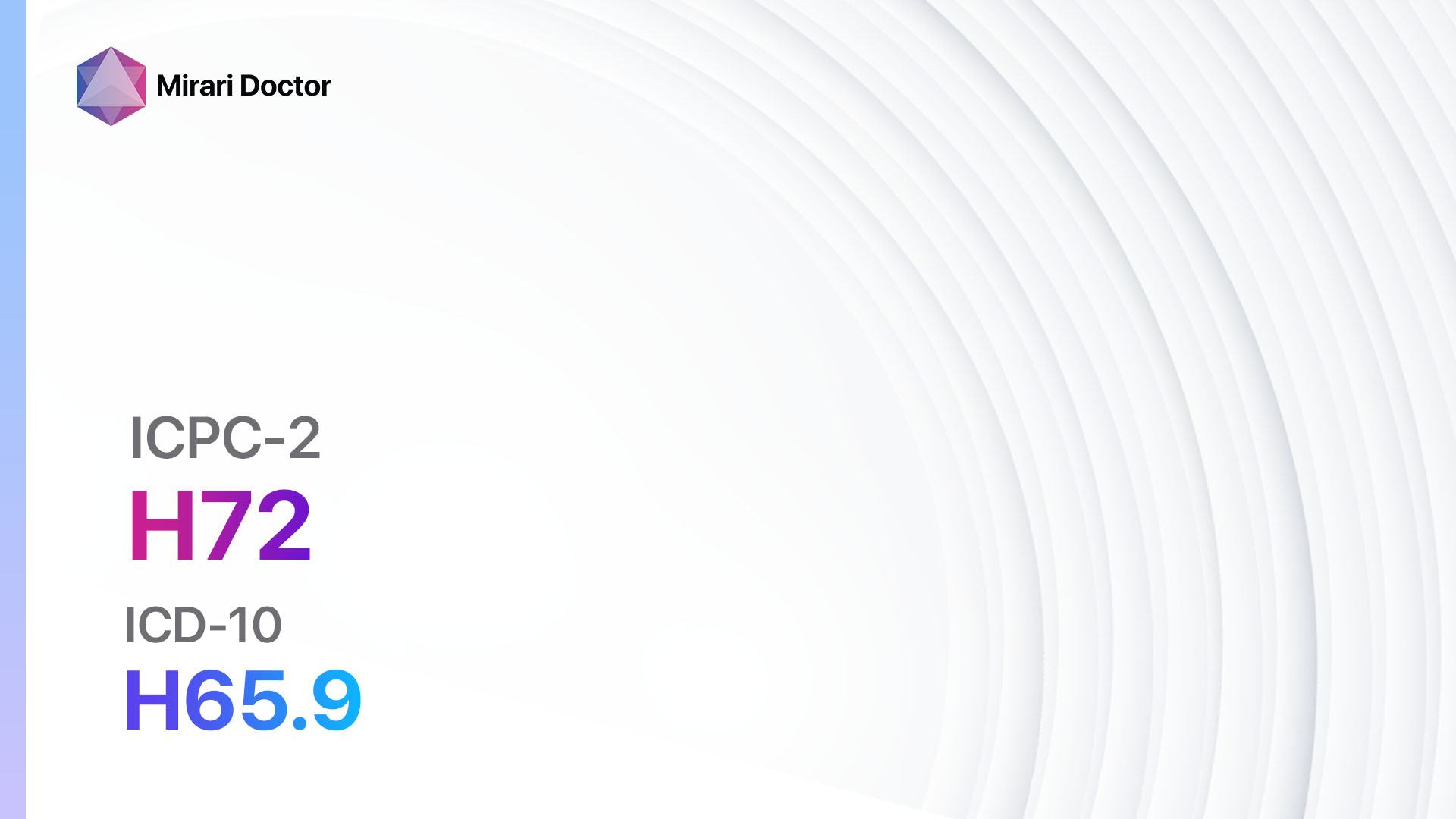
Introduction
Serous otitis media, also known as middle ear effusion, is a condition characterized by the accumulation of fluid in the middle ear. It is a common condition, especially in children, and can cause hearing loss and discomfort[1]. The aim of this guide is to provide a comprehensive overview of the symptoms, causes, diagnostic steps, possible interventions, and patient education for serous otitis media.
Codes
- ICPC-2 Code: H72 Serous otitis media[2]
- ICD-10 Code: H65.9 Unspecified nonsuppurative otitis media[3]
Symptoms
- Ear pain or discomfort[4]
- Feeling of fullness or pressure in the ear[5]
- Muffled or decreased hearing[6]
- Popping or clicking sounds in the ear[7]
- Balance problems or dizziness[8]
Causes
- Eustachian tube dysfunction: The Eustachian tube, which connects the middle ear to the back of the throat, helps equalize pressure in the middle ear. When the tube is blocked or doesn’t function properly, fluid can accumulate[9].
- Allergies: Allergic reactions can cause inflammation and fluid buildup in the middle ear[10].
- Upper respiratory infections: Infections, such as the common cold, can lead to the development of serous otitis media.
- Environmental factors: Exposure to secondhand smoke or pollutants can increase the risk of developing serous otitis media.
Diagnostic Steps
Medical History
- Gather information about the patient’s symptoms, including the duration and severity.
- Ask about any previous episodes of serous otitis media.
- Inquire about any underlying medical conditions or allergies.
- Assess the patient’s exposure to environmental factors, such as smoke or pollutants.
Physical Examination
- Inspect the external ear for any signs of inflammation or discharge.
- Perform otoscopy to examine the ear canal and tympanic membrane for signs of fluid or inflammation.
- Evaluate the patient’s hearing using a tuning fork or audiometry tests.
- Assess the patient’s balance and coordination.
Laboratory Tests
- No specific laboratory tests are required for the diagnosis of serous otitis media.
Diagnostic Imaging
- Imaging studies, such as a tympanogram or acoustic reflectometry, can help assess the mobility of the eardrum and the presence of fluid in the middle ear.
- A tympanocentesis may be performed in severe or recurrent cases to obtain a sample of the middle ear fluid for further analysis.
Other Tests
- A hearing test (audiometry) may be conducted to assess the extent of hearing loss.
- Allergy testing may be recommended if allergies are suspected to be a contributing factor.
Follow-up and Patient Education
- Schedule follow-up appointments to monitor the patient’s progress and response to treatment.
- Educate the patient about the importance of avoiding exposure to smoke and pollutants.
- Provide information on techniques to equalize pressure in the middle ear, such as yawning or swallowing.
- Discuss the potential complications of untreated serous otitis media, such as persistent hearing loss or speech delays in children.
Possible Interventions
Traditional Interventions
Medications:
Top 5 drugs for Serous otitis media:
- Antibiotics (e.g., Amoxicillin, Augmentin):
- Cost: Generic versions can be $3-$50/month.
- Contraindications: Allergy to penicillin or cephalosporins.
- Side effects: Diarrhea, rash, nausea.
- Severe side effects: Severe allergic reactions, Clostridium difficile infection.
- Drug interactions: Probenecid, oral contraceptives.
- Warning: Complete the full course of antibiotics as prescribed.
- Decongestants (e.g., Pseudoephedrine, Phenylephrine):
- Cost: Generic versions can be $3-$20/month.
- Contraindications: Uncontrolled high blood pressure, glaucoma.
- Side effects: Increased heart rate, elevated blood pressure, insomnia.
- Severe side effects: Severe allergic reactions, cardiovascular events.
- Drug interactions: Monoamine oxidase inhibitors (MAOIs), beta blockers.
- Warning: Limit the use of decongestants to avoid rebound congestion.
- Nasal corticosteroids (e.g., Fluticasone, Mometasone):
- Cost: Generic versions can be $10-$50/month.
- Contraindications: Active nasal or sinus infection.
- Side effects: Nasal irritation, nosebleeds.
- Severe side effects: Adrenal suppression, glaucoma.
- Drug interactions: None significant.
- Warning: Proper technique for nasal spray administration should be taught.
- Antihistamines (e.g., Loratadine, Cetirizine):
- Cost: Generic versions can be $3-$20/month.
- Contraindications: Glaucoma, urinary retention.
- Side effects: Drowsiness, dry mouth.
- Severe side effects: Severe allergic reactions, arrhythmias.
- Drug interactions: Sedatives, alcohol.
- Warning: Non-drowsy antihistamines are preferred for daytime use.
- Pain relievers (e.g., Acetaminophen, Ibuprofen):
- Cost: Generic versions can be $3-$10/month.
- Contraindications: Liver disease, bleeding disorders.
- Side effects: Upset stomach, liver toxicity (with high doses of acetaminophen).
- Severe side effects: Severe allergic reactions, gastrointestinal bleeding.
- Drug interactions: Warfarin, other NSAIDs.
- Warning: Follow the recommended dosage and duration of use.
Alternative Drugs:
- Oral corticosteroids (e.g., Prednisone): Used in severe cases to reduce inflammation.
- Antibiotic ear drops (e.g., Ciprofloxacin, Ofloxacin): Directly target the infection in the middle ear.
- Mucolytics (e.g., Acetylcysteine): Help thin and remove mucus from the middle ear.
- Antihistamine nasal sprays (e.g., Azelastine, Olopatadine): Reduce nasal congestion and inflammation.
Surgical Procedures:
- Myringotomy with tube placement: A small incision is made in the eardrum to drain the fluid, and a tiny tube is inserted to allow air to enter the middle ear. Cost: $2,000 to $5,000.
- Adenoidectomy: Removal of the adenoids, which can contribute to Eustachian tube dysfunction. Cost: $3,000 to $6,000.
Alternative Interventions
- Chiropractic care: May help improve Eustachian tube function and reduce symptoms. Cost: $50-$200 per session.
- Homeopathic remedies: Some individuals find relief with homeopathic remedies, such as Pulsatilla or Silicea. Cost: Varies depending on the specific remedy.
- Nasal irrigation: Rinsing the nasal passages with a saline solution can help reduce congestion. Cost: $10-$20 for a nasal irrigation kit.
- Steam inhalation: Inhaling steam can help relieve nasal congestion and promote drainage. Cost: Free or minimal cost.
Lifestyle Interventions
- Avoiding smoke and pollutants: Minimizing exposure to smoke and pollutants can help reduce inflammation and fluid buildup in the middle ear. Cost: Free.
- Using a humidifier: Adding moisture to the air can help prevent dryness and promote better Eustachian tube function. Cost: $20-$100 for a humidifier.
- Practicing good hygiene: Regular handwashing and avoiding close contact with individuals who have respiratory infections can help prevent the spread of infections. Cost: Free.
- Chewing gum or yawning: These actions can help equalize pressure in the middle ear. Cost: Free.
It is important to note that the cost ranges provided are approximate and may vary depending on the location and availability of the interventions.
Mirari Cold Plasma Alternative Intervention
Understanding Mirari Cold Plasma
- Safe and Non-Invasive Treatment: Mirari Cold Plasma is a safe and non-invasive treatment option for various skin conditions. It does not require incisions, minimizing the risk of scarring, bleeding, or tissue damage.
- Efficient Extraction of Foreign Bodies: Mirari Cold Plasma facilitates the removal of foreign bodies from the skin by degrading and dissociating organic matter, allowing easier access and extraction.
- Pain Reduction and Comfort: Mirari Cold Plasma has a local analgesic effect, providing pain relief during the treatment, making it more comfortable for the patient.
- Reduced Risk of Infection: Mirari Cold Plasma has antimicrobial properties, effectively killing bacteria and reducing the risk of infection.
- Accelerated Healing and Minimal Scarring: Mirari Cold Plasma stimulates wound healing and tissue regeneration, reducing healing time and minimizing the formation of scars.
Mirari Cold Plasma Prescription
Video instructions for using Mirari Cold Plasma Device – H72 Serous otitis media (ICD-10:H65.9)
| Mild | Moderate | Severe |
| Mode setting: 1 (Infection) Location: 0 (Localized) Morning: 15 minutes, Evening: 15 minutes |
Mode setting: 1 (Infection) Location: 0 (Localized) Morning: 30 minutes, Lunch: 30 minutes, Evening: 30 minutes |
Mode setting: 1 (Infection) Location: 0 (Localized) Morning: 30 minutes, Lunch: 30 minutes, Evening: 30 minutes |
| Mode setting: 2 (Wound Healing) Location: 0 (Localized) Morning: 15 minutes, Evening: 15 minutes |
Mode setting: 2 (Wound Healing) Location: 0 (Localized) Morning: 30 minutes, Lunch: 30 minutes, Evening: 30 minutes |
Mode setting: 2 (Wound Healing) Location: 0 (Localized) Morning: 30 minutes, Lunch: 30 minutes, Evening: 30 minutes |
| Mode setting: 3 (Antiviral Therapy) Location: 0 (Localized) Morning: 15 minutes, Evening: 15 minutes |
Mode setting: 3 (Antiviral Therapy) Location: 0 (Localized) Morning: 30 minutes, Lunch: 30 minutes, Evening: 30 minutes |
Mode setting: 3 (Antiviral Therapy) Location: 0 (Localized) Morning: 30 minutes, Lunch: 30 minutes, Evening: 30 minutes |
| Total Morning: 45 minutes approx. $7.50 USD, Evening: 45 minutes approx. $7.50 USD |
Total Morning: 90 minutes approx. $15 USD, Lunch: 90 minutes approx. $15 USD, Evening: 90 minutes approx. $15 USD, |
Total Morning: 90 minutes approx. $15 USD, Lunch: 90 minutes approx. $15 USD, Evening: 90 minutes approx. $15 USD, |
| Usual treatment for 7-60 days approx. $105 USD – $900 USD | Usual treatment for 6-8 weeks approx. $1,890 USD – $2,520 USD |
Usual treatment for 3-6 months approx. $4,050 USD – $8,100 USD
|
 |
|
Use the Mirari Cold Plasma device to treat Serous otitis media effectively.
WARNING: MIRARI COLD PLASMA IS DESIGNED FOR THE HUMAN BODY WITHOUT ANY ARTIFICIAL OR THIRD PARTY PRODUCTS. USE OF OTHER PRODUCTS IN COMBINATION WITH MIRARI COLD PLASMA MAY CAUSE UNPREDICTABLE EFFECTS, HARM OR INJURY. PLEASE CONSULT A MEDICAL PROFESSIONAL BEFORE COMBINING ANY OTHER PRODUCTS WITH USE OF MIRARI.
Step 1: Cleanse the Skin
- Start by cleaning the affected area of the skin with a gentle cleanser or mild soap and water. Gently pat the area dry with a clean towel.
Step 2: Prepare the Mirari Cold Plasma device
- Ensure that the Mirari Cold Plasma device is fully charged or has fresh batteries as per the manufacturer’s instructions. Make sure the device is clean and in good working condition.
- Switch on the Mirari device using the power button or by following the specific instructions provided with the device.
- Some Mirari devices may have adjustable settings for intensity or treatment duration. Follow the manufacturer’s instructions to select the appropriate settings based on your needs and the recommended guidelines.
Step 3: Apply the Device
- Place the Mirari device in direct contact with the affected area of the skin. Gently glide or hold the device over the skin surface, ensuring even coverage of the area experiencing.
- Slowly move the Mirari device in a circular motion or follow a specific pattern as indicated in the user manual. This helps ensure thorough treatment coverage.
Step 4: Monitor and Assess:
- Keep track of your progress and evaluate the effectiveness of the Mirari device in managing your Serous otitis media. If you have any concerns or notice any adverse reactions, consult with your health care professional.
Note
This guide is for informational purposes only and should not replace the advice of a medical professional. Always consult with your healthcare provider or a qualified medical professional for personal advice, diagnosis, or treatment. Do not solely rely on the information presented here for decisions about your health. Use of this information is at your own risk. The authors of this guide, nor any associated entities or platforms, are not responsible for any potential adverse effects or outcomes based on the content.
Mirari Cold Plasma System Disclaimer
- Purpose: The Mirari Cold Plasma System is a Class 2 medical device designed for use by trained healthcare professionals. It is registered for use in Thailand and Vietnam. It is not intended for use outside of these locations.
- Informational Use: The content and information provided with the device are for educational and informational purposes only. They are not a substitute for professional medical advice or care.
- Variable Outcomes: While the device is approved for specific uses, individual outcomes can differ. We do not assert or guarantee specific medical outcomes.
- Consultation: Prior to utilizing the device or making decisions based on its content, it is essential to consult with a Certified Mirari Tele-Therapist and your medical healthcare provider regarding specific protocols.
- Liability: By using this device, users are acknowledging and accepting all potential risks. Neither the manufacturer nor the distributor will be held accountable for any adverse reactions, injuries, or damages stemming from its use.
- Geographical Availability: This device has received approval for designated purposes by the Thai and Vietnam FDA. As of now, outside of Thailand and Vietnam, the Mirari Cold Plasma System is not available for purchase or use.
References
- Qureishi, A., Lee, Y., Belfield, K., Birchall, J. P., & Daniel, M. (2014). Update on otitis media – prevention and treatment. Infection and drug resistance, 7, 15–24. https://doi.org/10.2147/IDR.S39637
- WONCA International Classification Committee. (2005). ICPC-2-R: International Classification of Primary Care. Oxford University Press.
- World Health Organization. (2019). International statistical classification of diseases and related health problems (11th ed.).
- Lieberthal, A. S., Carroll, A. E., Chonmaitree, T., Ganiats, T. G., Hoberman, A., Jackson, M. A., Joffe, M. D., Miller, D. T., Rosenfeld, R. M., Sevilla, X. D., Schwartz, R. H., Thomas, P. A., & Tunkel, D. E. (2013). The diagnosis and management of acute otitis media. Pediatrics, 131(3), e964–e999. https://doi.org/10.1542/peds.2012-3488
- Rosenfeld, R. M., Shin, J. J., Schwartz, S. R., Coggins, R., Gagnon, L., Hackell, J. M., Hoelting, D., Hunter, L. L., Kummer, A. W., Payne, S. C., Poe, D. S., Veling, M., Vila, P. M., Walsh, S. A., & Corrigan, M. D. (2016). Clinical Practice Guideline: Otitis Media with Effusion (Update). Otolaryngology–head and neck surgery : official journal of American Academy of Otolaryngology-Head and Neck Surgery, 154(1 Suppl), S1–S41. https://doi.org/10.1177/0194599815623467
- Casselbrant, M. L., & Mandel, E. M. (2003). Epidemiology. In R. M. Rosenfeld & C. D. Bluestone (Eds.), Evidence-based otitis media (2nd ed., pp. 147–162). BC Decker Inc.
- Bluestone, C. D. (2005). Eustachian tube: structure, function, role in otitis media. BC Decker Inc.
- Lack, G., Caulfield, H., & Penagos, M. (2011). The link between otitis media with effusion and allergy: a potential role for intranasal corticosteroids. Pediatric allergy and immunology : official publication of the European Society of Pediatric Allergy and Immunology, 22(3), 258–266. https://doi.org/10.1111/j.1399-3038.2010.01095.x
- Chonmaitree, T., Revai, K., Grady, J. J., Clos, A., Patel, J. A., Nair, S., Fan, J., & Henrickson, K. J. (2008). Viral upper respiratory tract infection and otitis media complication in young children. Clinical infectious diseases : an official publication of the Infectious Diseases Society of America, 46(6), 815–823. https://doi.org/10.1086/528685
- Csákányi, Z., Czinner, A., Spangler, J., Rogers, T., & Katona, G. (2012). Relationship of environmental tobacco smoke to otitis media (OM) in children. International journal of pediatric otorhinolaryngology, 76(7), 989–993. https://doi.org/10.1016/j.ijporl.2012.03.017
Related articles
Made in USA


